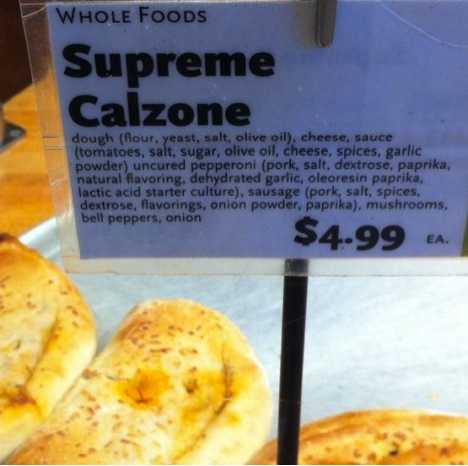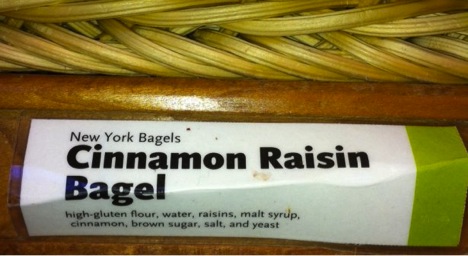Fooducate Blog - Where’s the “Whole” in Whole Foods Market? |
| Where’s the “Whole” in Whole Foods Market? Posted: 12 Jun 2012 03:11 AM PDT
Or try Fooducate on the Web! This is a guest blog post by Carol Harvey, director of nutrition labeling at Palate Works. Something has been "softly" incongruous about Whole Foods since the opening of their first store a thousand years ago: The pastry case… and their lily-white fresh-baked goods in general. The stuff looks and tastes good (at least in a very traditional/"European"/no-blemish sort of way), and they use nothing but "the best quality butter and unbromated flour." But why is the temple of "whole" using 100% un-whole flour for most of their baked goods (cakes, muffins, cookies, etc.)? Even their in-store pizza is made with 100% refined wheat (aka white) flour. There's something not so real about that deal. (Note: They recently started to offer a limited assortment of partially-whole-grain packaged muffins and refrigerated, ready-to-bake pizzas). Here are ingredient lists for various Whole Foods Market house-made items. Note that wheat flour is refined if it isn't listed as "whole wheat". Natural Goodies snickerdoodle cookies: And the Nutrition Facts (note that the serving size is large, almost two FDA cookie servings, but fiber is still only 1 g): Croutons (note out-of-sequence ingredients list… one would think and hope that yeast and salt are less predominant than olive oil, especially when the product is noticeably oily): And a typical store-baked pizza (note use of the term "flour" rather than "wheat flour", and the breakdown of the sauce ingredients but not the cheese ingredients): Meanwhile, Whole Foods still lists "flour" on the ingredient lists for many of their fresh baked goods, rather than WHEAT flour, which is what it is. Here is the calzone sign, with no mention of wheat anywhere (but it's obviously made with refined wheat flour). Label courtesy of Whole Foods – a company that now courts the gluten-intolerant with a new line of gluten-free baked goods. This one gets the "wheat flour" right, but screws up the punctuation ("enriched, wheat flour" means enriched is the first ingredient and wheat flour is the second), and invents a new vitamin (thaymine) and a new kind of malted flour ("malted bakery flour" should be "malted barley flour"): Not long ago, my local store had a "wheat free" sign on fresh baked muffins and scones that listed "flour" in the ingredients rather than "wheat flour," even though "flour" ALWAYS means wheat flour. Makes you wonder 1) how many gluten-intolerant/wheat-allergic people bought those thinking they were ok to eat, 2) how a staff member could have thought "flour" wasn't a wheat ingredient, and 3) how the store expected customers to know flour = wheat flour when their own staff can't figure it out. (Note: I had this come up in a restaurant where the waitress said there was no wheat in a muffin, just sperry blossom flour. She didn't know that Sperry Blossoms is a Gold Medal brand of wheat flour). A vendor's bagel in the muffin case still shows a lack of specifics as to the kind of "flour": If Pizzeria Uno (among other chains with similar offerings) can make a partially whole grain crust with 9 g fiber per serving, Whole Foods Market should be able to offer something at least as good, especially with all those high quality ingredients for which their customers have proven willing to pay a premium. The nutrition benefits are a given. As for taste… using part whole grain flours actually improves flavor and texture, because white/refined flour has little or none – by definition (they were stripped out). And where do we see just that memo? On the Whole Foods web site: http://www2.wholefoodsmarket.com/recipes/guides/grains.php. There is even a "white whole wheat flour" (spring white wheat) for those who can't handle earth tones in their baked goods, so replacing at least 50% of refined flour with whole grain couldn't be easier on the wholly challenged. Maybe Whole Foods Market could take a tip from their vendors who have been successfully using flours from whole grain wheat, rice, oat, barley, amaranth, etc. for years, and finally plug some holes in their not-so-holy interpretation of whole. Carol Harvey has been a nutrition labeling and product development consultant for over 15 years. She can be reached at palatemail [AT] yahoo [DOT] com. |
| You are subscribed to email updates from To stop receiving these emails, you may unsubscribe now. | Email delivery powered by Google |
| Google Inc., 20 West Kinzie, Chicago IL USA 60610 | |










No comments:
Post a Comment